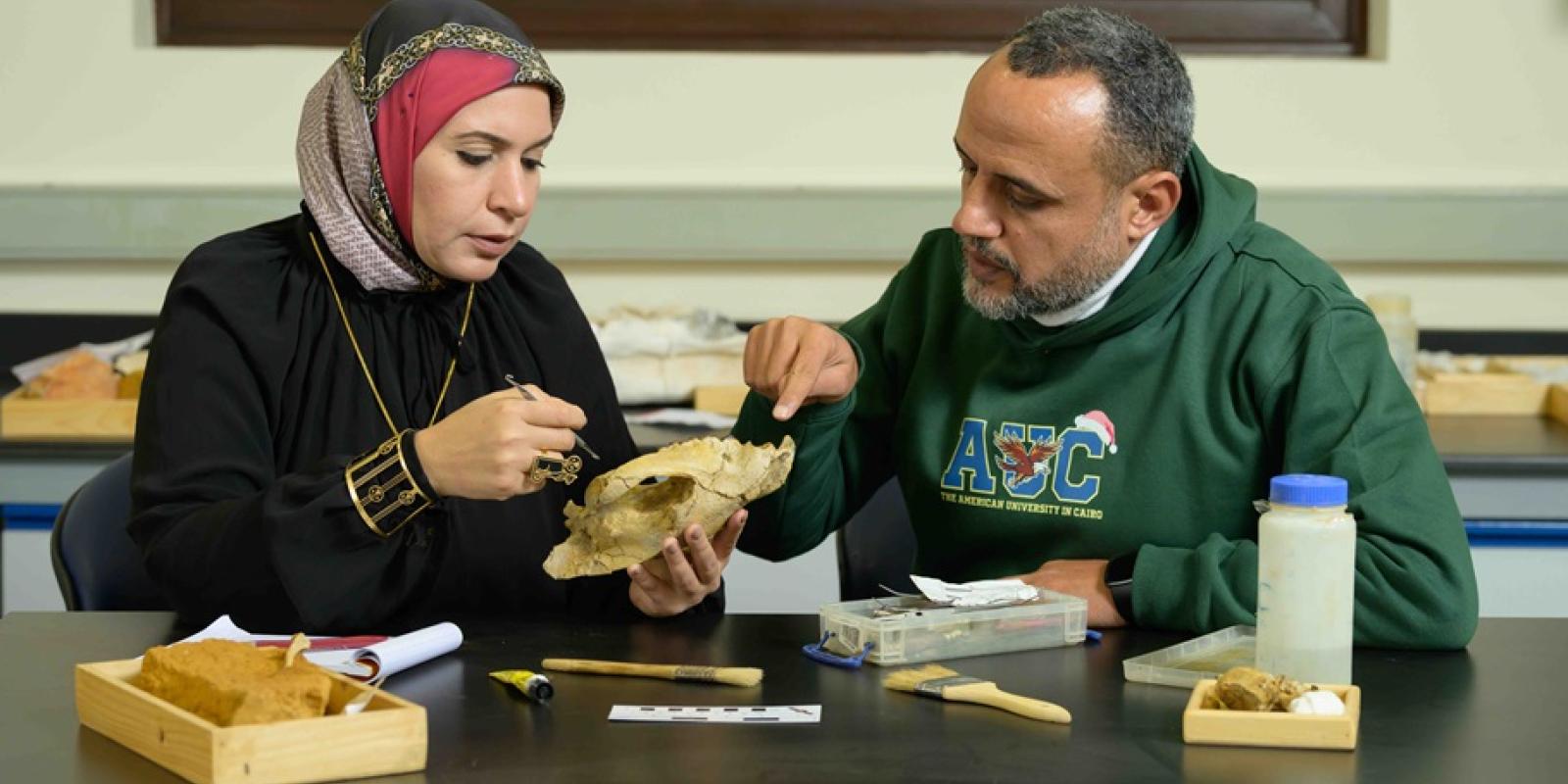
AUC Professor Hesham Sallam Leads The Discovery Of 30-Million-Year-Old Leopard-Sized Carnivore Skull
February 17, 2025, Cairo – Hesham Sallam, professor of vertebrate paleontology at The American University in Cairo (AUC) and founder of Mansoura University Vertebrate Paleontology Center (MUVP), was the senior author of an international study that led to the discovery of a nearly complete skull in the Egyptian desert. This finding has resulted in the groundbreaking revelation of a new 30-million-year-old species of the ancient apex predatory carnivore, Hyaenodonta. The paper, published today in the peer-reviewed Journal of Vertebrate Paleontology, was led by Shorouq Al-Ashqar, from Sallam Lab at AUC and Mansoura University in collaboration with researchers from Duke University, the University of Southern California, and the University of Michigan. The study, funded by Mansoura University, AUC, STDF and USAID, details how this ferocious creature likely preyed on primates, early hippos, early elephants, and hyraxes in the lush forests of Fayoum, Egypt—an area that is now a desert.
Describing the discovery, Al-Ashqar said that for days, the team meticulously excavated layers of rock dating back around 30 million years. “Just as they were about to conclude their work, Belal Salem, a team member, spotted something remarkable —a set of large teeth sticking out of the ground. His excited shout brought the team together, marking the beginning of an extraordinary discovery: a nearly complete skull of an ancient apex carnivore, a dream for any vertebrate paleontologist.”
Sallam explains that the skull was unearthed during his team’s expedition to the Fayoum Depression, an area where digs reveal an important time window into about 15 million years of evolutionary history of mammals in Africa. “This timespan not only captures the transition from the Eocene’s global warming to the Oligocene’s global cooling, but also reveals how these climate shifts played a crucial role in shaping ecosystems that we still see today.”
Bearing sharp teeth and powerful jaw muscles, suggesting a strong bite, the newly-identified ‘Bastetodon,’ named after the cat-headed ancient Egyptian goddess Bastet, was a leopard-sized “fearsome” mammal that belongs to a species in an extinct group of carnivorous mammals called hyaenodonts. Hyaenodonts evolved long before modern-day carnivores such as cats, dogs, and hyenas. These predators with hyena-like teeth hunted in African ecosystems after the extinction of the dinosaurs.
Beyond just a new ancient creature discovery, the finding of Bastetodon has already allowed the research team to reevaluate a group of lion-sized hyaenodonts that was discovered in the rocks of the Fayoum over 120 years ago.
In their paper the team also construct the genus Sekhmetops to describe this century-old material and to honor Sekhmet, the lion-headed goddess of wrath and war in ancient Egyptian mythology (“-ops” means “face”). In 1904, Sekhmetops was placed within a European group of hyaenodonts. The team demonstrated Bastetodon and Sekhmetops both belonged to a group of hyaenodonts that actually originated in Africa. In ancient Egypt, Bastet was often associated with Sekhmet, making the two genera scientifically and symbolically connected.
The study demonstrates the relatives of Bastetodon and Sekhmetops spread from Africa in multiple waves, eventually making it to Asia, Europe, India, and North America. By 18 million years ago, some relatives of these hyaenodonts were among the largest mammalian meat-eaters to ever walk the planet.
However, cataclysmic changes in global climate and tectonic changes in Africa opened the continent to the relatives of modern cats, dogs, and hyenas. As environments and prey changed, the specialized, carnivorous hyaenodonts diminished in diversity, finally going extinct and leaving our primate relatives to face a new set of antagonists.
“The discovery of Bastetodon is a significant achievement in understanding the diversity and evolution of hyaenodonts and their global distribution,” Shorouq noted.
“We are eager to continue our research to unravel the intricate relationships between these ancient predators and their environments over time and across continents.”
Co-author Matt Borths, curator of Fossils at the Duke Lemur Center Museum of Natural History at Duke University in Durham, North Carolina, said: “The Fayoum is one of the most important fossil areas in Africa. Without it, we would know very little about the origins of African ecosystems and the evolution of African mammals like elephants, primates, and hyaenodonts. Paleontologists have been working in the Fayoum for over a century, but the Sallam Lab demonstrated there is more to discover in this remarkable region.”